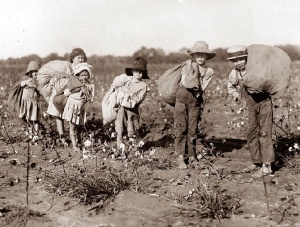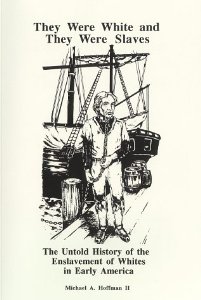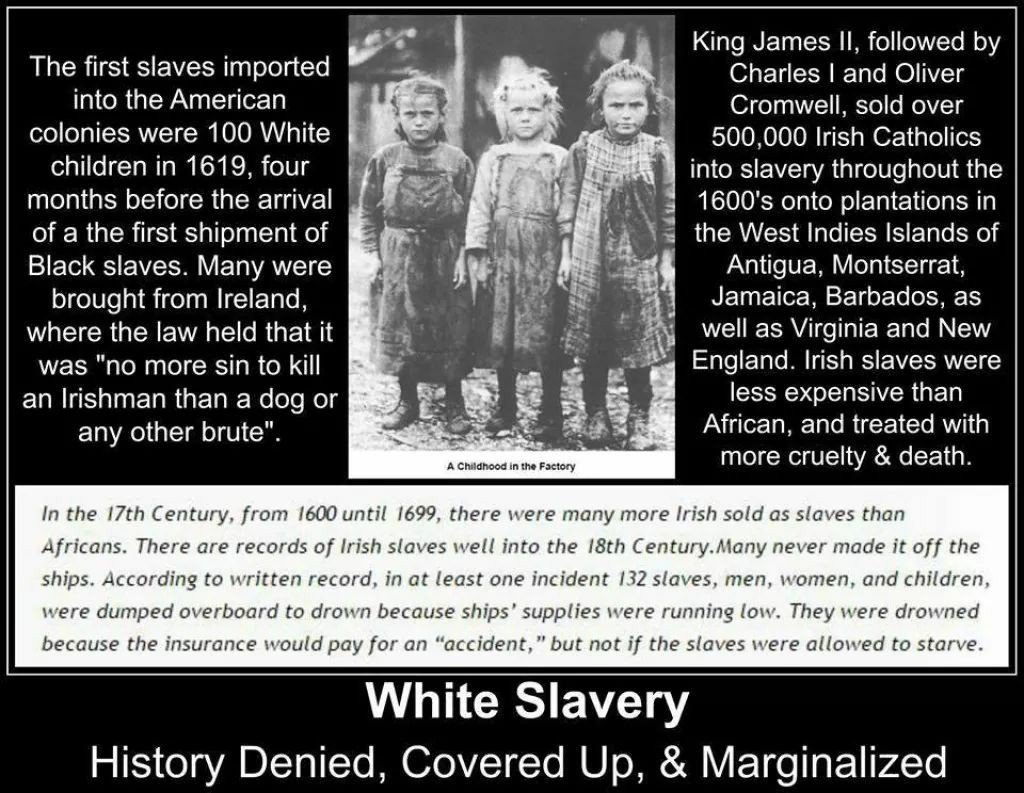White Slavery in America
12FridayApr 2013
Posted in White Slaves
Tags
“17th and 18th century ‘economists’ advocated the enslavement of poor Whites because they saw them as the cheapest and most effective way to develop the colonies in the New World and expand the British empire. As the plantation system expanded in the southern American colonies, planters demanded the legalization of the practice of kidnapping poor Whites.”
Even if they attained their freedom, dirt-poor Whites were forced to compete against negro slave labor. Jobs were few and Southern planters sat idly as poor Whites died of malnutrition for want of food and medicine. Negro slaves were expensive. To protect their investments, White aristocrats usually treated their negro slaves well, providing for adequate food, clothing and medication even as poor Whites in the same town sickened and died from disease and malnutrition.
Try to envision the 19th century scene: yeoman southern Whites, sick and destitute, watching their children dying while enduring the spectacle of negroes from the jungles of Africa healthy and well-fed thanks to the ministrations of their fabulously wealthy White owners who cared little or nothing for the local “White trash.”
Protectionism, Free Trade, and the Civil War
In the course of an 1855 journey up the Alabama River on the steamboat Fashion, Frederic Law Olmsted, the landscape architect who designed New York’s Central Park, observed bales of cotton being thrown from a considerable height into a cargo ship’s hold. The men tossing the bales somewhat recklessly into the hold were negroes, the men in the hold were Irish. Olmsted inquired about this to a mate on the ship. ‘Oh, said the mate, ‘the niggers are worth too much to be risked here; if the Paddies are knocked overboard or get their backs broke, nobody loses anything.” (Frederic Law Olm-sted, A Journey to the Seaboard Slave States, pp. 100-101; G.E.M. de Ste. Croix, Slavery and Other Forms of Unfree Labor, p. 27).
In the antebellum South, “Gangs of Irish immigrants worked ditching and draining plantations, building levees and sometimes clearing land because of the danger to valuable (negro) slave property …George Templeton Strong, a Whig patrician diarist… considered Irish workmen at his home to have had ‘prehensile paws’ rather than hands. He denounced the ‘Celtic beast’… Irish youths… were sometimes called ‘Irish slaves’ and more frequently ‘bound boys’…” A common joke in the South in the pre-Civil War period was that when Blacks were ordered to work hard they complained that their masters were treating them ‘like Irishmen.’ (Roediger, pp. 133, 146,150).*
“When I was a boy,’ recalled Waters Mcintosh, who had been a slave in Sumter, South Carolina, ‘we used to sing, ‘Rather be a nigger than a poor white man.’ Even in slavery we used to sing that.’
“Mr. McIntosh’s remarks reveal… that the poor whites of the South ranked below blacks in social standing… slaves felt unbridled contempt for lower-class whites… Frederick Douglass opened his famous Life and Times with an account of Talbot County, Maryland, which he said housed a ‘white population of the lowest order…
“Throughout the South the slaves of many of the larger planters lived in a society of blacks and well-to-do whites and were encouraged to view even respectable laboring Whites with disdain… Ella Kelly, who had been a slave in South Carolina:
“…You know, boss, dese days dere is three kind of people. Lowest down is a layer of white folks, then in de middle is a layer of colored folks, and on top is de cream, a layer of good white folks…
“The slaves noticed their masters sense of superiority toward marginal farmers as well as toward poor whites and, by associating themselves with ‘de quality white folks,’ strengthened their self-esteem…
“…a slave… expressed no surprise that his master, who was Big Buckra, never associated with white trash. And Rosa Starke, who had been owned by a big planter in South Carolina, reported that poor whites had to use the kitchen door when they went up to the Big House. Her mistress ‘had a grand manner; no patience with poor white folks.’
“…The many (negro) ex-slaves who recalled the lot of the small farmers and poor whites as hard and even as bad as their own knew what they were talking about.
“…The slaves saw enough abject poverty, disease, and demoralization among the poor whites… to see their own condition under Ole Massa’s protection as perhaps not the worst of evils.” (Eugene D. Genovese, “Rather Be a Nigger Than a Poor White Man’: Slave Perceptions of Southern Yeoman and Poor Whites,” in Toward a New View of America, pp. 79, 81-82, 84, 90-91).
This situation engendered a rage in the descendants and survivors of White slavery which has seldom been accounted for in the history of White working class support for the Northern abolitionist cause. We can gauge the attitude of yeoman Whites, especially in the border states like Kentucky and Tennessee, but throughout the U.S.A. as well, who were either neutral during the Confederacy’s struggle or sided with Lincoln, from the statement of an Iowa Congressman who maintained that it was the planter aristocracy “which exalts and spreads Africans at the expense of the White race.” (Emma Lou Thornbrough, “The Race Issue in Indiana Politics During the Civil War,” Indiana Magazine of History, June, 1951).
Some of the leaders of the Free Soil Party and many of the Unionist soldiers who made up the ranks of Lincoln’s armies in southern Ohio, western North Carolina, eastern Tennessee, southern Illinois, Kentucky and elsewhere were survivors of White slavery or descendants of White slaves. They did not view themselves as advocates of what was then referred to as racial “amalgamation.”
Historically they regarded themselves as separatists and viewed the Southern planter’s desire to spread negroes into California, Oregon and other territories as a grave threat to free White labor and the Old Testament principle of racial separation (Nehemiah 13:23-27; Ezra 10:10-14; Hosea 5:7).
Congressman David Wilmot sponsored a law to ban Black slavery in the American West. He dubbed his proposed law, “the White Man’s Proviso.” He was bitterly opposed by the Southern elite. Wilmot told Congress that he intended to preserve America’s western frontier for “the sons of toil, my own race and color.” (Charles B. Going, David Wilmot: Free-Soiler, p. 174).
During much of the Civil War the political and military leaders of the Confederacy could not travel in certain parts of the Deep South without armed escorts (Jeffrey Rogers Hummel, “The Civil War,” The United States at War Audio Classics Series, Part Two), for fear of attack from “Upcountry” Southern Whites who hated the planter aristocracy and the war they saw as being for the sole benefit of the expansion of the planter’s “infernal negroes.” Upcountry Southern Whites consisted in large part of the survivors and the children of the survivors of White slavery who resided in the hills, mountains and Piedmont regions of the South under frontier conditions.
In the antebellum 19th century South, “A large number of white Southerners lived in the upcountry, an area of small farmers and herdsmen… engaged largely in mixed and subsistence agriculture… Little currency circulated, barter was common and upcountry families dressed in ‘homespun cloth, the product of the spinning wheel and the hand-loom.’ This economic order gave rise to a distinctive subculture that celebrated mutuality, egalitarianism (for whites) and… independence.
“…mountain counties rejected secession from the outset. One citizen of Winston County in the northern Alabama hill country believed yeoman had no business fighting for a planter-dominated aristocracy: ‘All tha want is to git you… to fight for their infernal negroes and after you do their fightin’ you may kiss their hind parts for o tha care.” (Eric Foner, Reconstruction: America’s Unfinished Revolution, 1863-1877, pp. 11 and 13).
Poor Whites had to be drafted into the Confederate army. As in the North, where resistance to conscription was widespread, many Southern Whites saw the conflict as “a rich man’s war and a poor man’s fight.” Indeed, any slaveholder owning 20 or more Black slaves was exempt from military combat.
From 1609 until the early 1800s, between one-half and two-thirds of all the White colonists who came to the New World came as slaves. Of the passengers on the Mayflower, twelve were White slaves (John Van der Zee, Bound Over, p. 93). White slaves cleared the forests, drained the swamps, built the roads. They worked and died in greater numbers than anyone else.
Both psychologically and materially Whites in modern times are called upon to bear burdens of guilt and monetary reparation for negro slavery. This position is based entirely on enforced ignorance and the deliberate suppression of the record of White slavery in North America. Hundreds of thousands of Whites had been enslaved during the colonial era in America while millions of others were too poor to afford even a mule, much less a Black slave.
Slave reparations and guilty feelings are due – if one subscribes to such a thing as retroactive collective guilt – from the descendants of the minority of wealthy Whites who owned negro slaves and who, in the South at least, were themselves generally reduced to penury in the aftermath of the Civil War. Reparations would also have to be paid by the descendants of the Cherokee and other American Indian tribes who owned Black slaves and by the heirs of Black tribal leaders in Africa who sold them into slavery.
Reparations must also be paid, if the logic of the situation is to be consistent, to the modern day White descendants of the White slaves of early America.
The whole discussion of negro slavery, Southern racism and the Civil War as currently framed by the Establishment agenda, necessarily must exclude any examination of the fact of White slavery, especially in the 17th and 18th centuries, and the condition of free White poor in the 19th century forced to compete against negro slave labor in the South.
____________________
* Strong’s opinion was hardly unanimous. In the 1850s, Massachusetts legislator Caleb Cushing announced that he admitted “to an equality with me, sir, the White man – my blood and race – whether he be a Saxon of England or a Celt of Ireland… but I do not admit as my equals either the red man of America, or the yellow man of Asia, or the black of Africa”
____________________
* Strong’s opinion was hardly unanimous. In the 1850s, Massachusetts legislator Caleb Cushing announced that he admitted “to an equality with me, sir, the White man – my blood and race – whether he be a Saxon of England or a Celt of Ireland… but I do not admit as my equals either the red man of America, or the yellow man of Asia, or the black of Africa”
Irish-Americans were among the foremost fighters for the rights of White workers and for separation of the races. The term miscegenation (from the Latin, miscere, to mix and genus, for race) was coined by two Irishmen, George Wakeman and D.G. Croly, in their anonymously written, 1863 anti-integration satire, Miscegenation: The Theory of the Blending of the Races. The Englishman James D. Burn observed that, “…it is in the Irish residents that they (American negroes) have, and will continue to have, their most formidable enemies…” (Three Years Among the Working Classes in the U.S. During the [Civil] War, p. xiv). O
The great bulk of the legal voters of the South were men who owned no slaves; their homes were generally in the hills and poor country; their facilities for educating their children, even up to the point of reading and writing, were very limited; their interest in the contest was very meagre–what there was, if they had been capable of seeing it, was with the North; they too needed emancipation. Under the old regime they were looked down upon by those who controlled all the affairs in the interest of slave-owners, as poor white trash who were allowed the ballot so long as they cast it according to direction.”
― Ulysses S. Grant
The Irish were further exploited when the British began to “breed” Irish women – or girls, sometimes as young as 12 – with African males. Read More
“Oh,” said the worker, “the niggers are worth too much to be risked here; if the Paddies are knocked overboard or get their backs broke, nobody loses anything.” Read More
General Thomas Francis Meagher (pronounced Marr) became a leading spokesman for the Irish-American community, and when the Civil War began he rallied his countrymen to support the Union cause: “Every blow you strike in the cause of the Union,” he told his volunteers, “is aimed at the allies of England, the enemy of your land and race. Today it is for the American Republic we fight–tomorrow it will be for Ireland.”




 #BeBest and 6 others liked
#BeBest and 6 others liked


